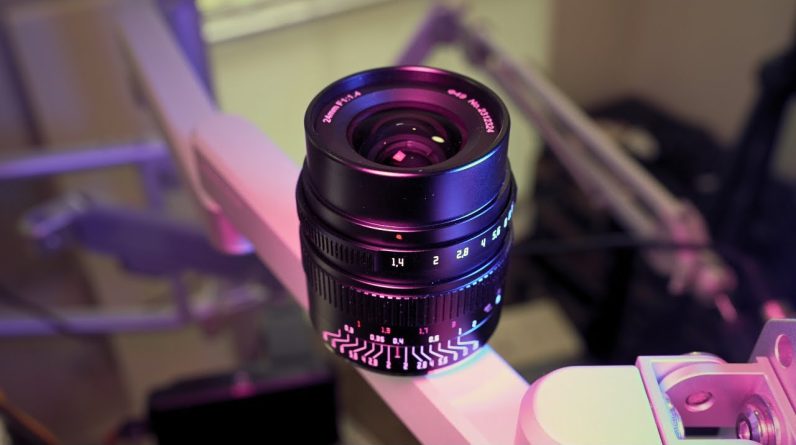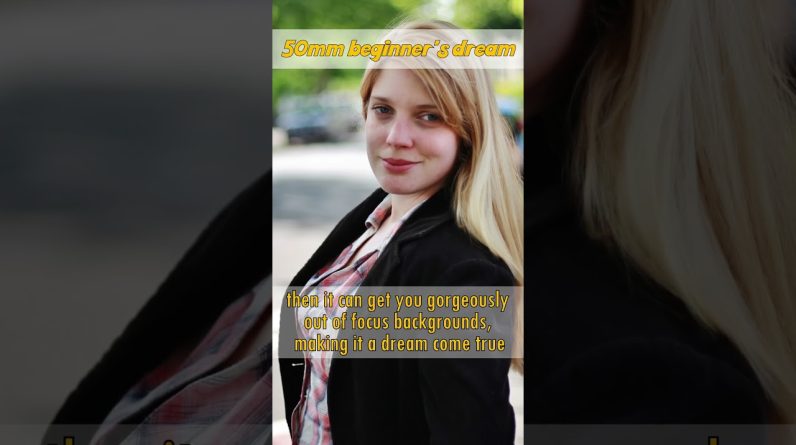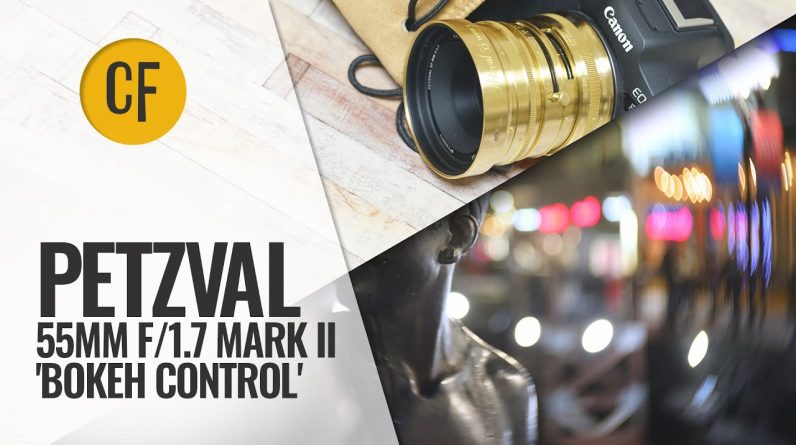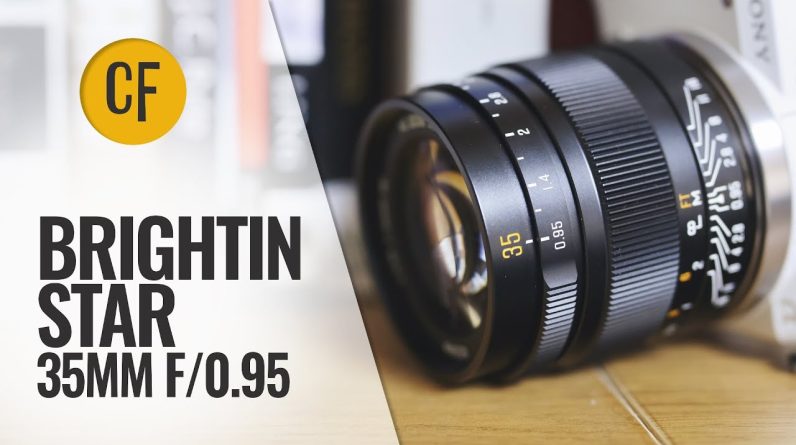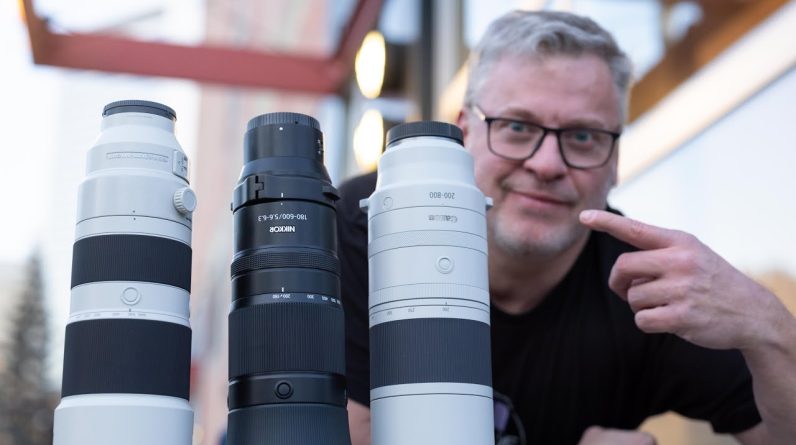[Music] Foreign Hi I'm Dustin Abbott and I'm here today To give you a review of an interesting Lens in that it is inexpensive but also It has the ability to produce really Quite Dynamic images and that is the per Gear 14 millimeter F 2.8 Mark II lens Now obviously since we're talking about A Mark II there was a original or Mark 1 Lens and per gear pretty quickly has Refreshed that lens addressing what were Some of the primary criticisms of it and So we have a lens that is smaller in Size obviously always important it has Reduced flare though as we're going to See not totally reduced as of yet it has A closer focusing distance at 21 Centimeters versus 43 centimeters for The original lens and there is a better Implementation of the filter ring for The lens and so some pretty significant Updates here and as we're going to find In many ways this is actually a very High performing lens despite its low Price tag of just 290 nine US dollars So a lens that you probably might be Interested in if you're looking for an Inexpensive wide angle option and one That actually even works for doing Astro And Interiors as we're going to see so Is this a lens that you should consider We'll discover that and explore it all Right after a word from our sponsor
Today's episode is brought to you by Into the am a clothing brand from Southern California that wants to outfit Your passion whatever it might be their Everyday comfortable fabrics and Designs Are great whether you are working from Home working out or even just chilling Out I love the fit and fabric on their Everyday t-shirts and you can choose More funky Styles created in Collaboration with local artists like This killer fractured King hoodie use The code Dustin tin or follow the link In the description to get 10 off Site-wide including their monthly T-shirt Club visit into the am.com Forward slash dustin10 for more Information So as noted this lens is reduced in size It is quite compact for a wide angle Wide aperture lens a prime lens it is 65 Millimeters in diameter and it is 80 Millimeters in length so that translates To 2.56 inches by 3.15 inches and it weighs in at a fairly Hefty 500 grams or 17.6 ounces despite It being so compact the reason for that Is that this is a quite a well-built Lens everything here is all in metal Everything feels quite nice the handling Of the lens feels really quite good and So as a byproduct you have a lens that Is Palm sized but has some heft to it That in many ways reminds me of a Zeiss
Type lens because of a lot of density There and the overall build now this is A manual everything lens we have a Manual aperture ring a manual focus ring We have no electronics more on that in Just a moment when it comes to the Actual function of these the manual Focus ring has about 100 110 degree of Rotation it actually moves really Beautifully has very nice damping I love The weight of it very smooth no friction Points nothing that feels gritty about It the aperture ring also moves nicely It has half stopped tints from F 2.8 to F 5.6 for a little bit more Precision After that point you only have full full Stop detents from F 5.6 to f8 onto F22 I Will note one issue here and that is That my on my copy this is not perfectly Calibrated and that you can go a little Bit to the left of f 2.8 and you can go Considerably to the right of F20 F22 so There isn't a perfect alignment between What is printed on the aperture ring and Where the actual stops or detents are on That so that's maybe one evidence that I Found of this being more of a budget Lens Now one of the things that they Addressed here is that rather than the Previous design of the lens which flared Out con significantly at the front of The lens we have a lens design here that For a wide angle lens like this it
Actually stays quite constant in terms Of the diameter so we do still have a Minor fixed lens hood here we have a Lens cap that goes over the top of that It fits on through suction and just a Little bit of friction and it fits in There nicely there's no possibility of This shaking loose and so that is a nice Fit there but we also have a novel Approach to the ability to filter the Lens often lenses with the bulbous front Element like this lens you can't use Traditional screw in filters but what They've done is they've provided you Another very nicely made metal piece That bayonets on almost like a lens Hood In many cases you bayonet that into Place it fits on nice and securely and What it does do is it now provides you With 82 millimeter front filter threads And so you can filter the lens now I did Find that with just this in place there Is no additional vignette as you can see In this comparison however if you are Using a a filter ND type filter where You're going to do a longer exposure you Will see increased vignette mostly Because not because of a mechanical Block but because this lens does have Some fairly High natural vignette and That magnifies the longer that the Exposure is the more you limit the light The more that disparity seems to shine Out
So anyway I do think that this is a Really nice filtering solution and if I Had one suggestion because it worked so Well I would say maybe give us an 82 Millimeter pinch cap as well because I Suspect many people wouldn't mind Leaving this all together like this all The time because the lens is still quite Compact even with that filter holder in Place as it stands you can't really use This because it has no ability to to fit In there via suction any longer and so You're left with that front element Exposed unless you remove the filter Holder there are 10 aperture blades Inside and so that creates a unique 10 Bladed sun star under the right Conditions as noted previously the Minimum Focus distance has dramatically Reduced however the magnification level Is still really low I'm going to Estimate it at somewhere about 0.07 or 0.08 times it is really still Quite low you're not going to confuse This with a macro type lens at all Now when it comes to the fact that there Are no electronics that means there's no There's also no weather sealing here and Nothing to communicate information to The camera itself so in terms of rear Wheel handling what does that mean well It means that certain lens specific Information is not going to be Transmitted to the camera so for example
In your XF data which you know is marked On your photos it's not going to tell You what the lens was or the focal Length or the aperture value because all Of those things are lens specific what You will have is the information about The iso and the shutter speed because Those come from the camera and not from The lens itself When it comes to actually using this Lens as far as the handling goes with a Wide a wide angle lens like this the Most of the time unless you are focusing At something very close Focusing is really couldn't be simpler I Found that on this my copy that Infinity Is calibrated right to where the hard Stop is and so frankly you can either go All the way to there or stop a little Bit short of that and if you're stopped Down to F4 F 5.6 f8 everything is going To be in Focus you really just have to Set focus and forget about it in fact I Didn't have one miss Focus shot when I Look back through all of my shots from My trip for example And the truth of the matter is that in Most situations I wasn't even really Focusing because I just set focus and Then I just took photos with it now if You need to focus closer you can have Focus overlays like peaking you can also Just magnify the image in the viewfinder For the various mounts this Lens comes I
Tested in Sony email but it also comes In Leica L comes in Canon RF Nikon Z or Zed Mount and so a lot of different Full-frame mirrorless cameras but all of Those share the ability to have Focus Aid so Focus not hard at all what I did Find however is because this lens Doesn't have electronics and it also has A lot of vignette sometimes metering Wasn't perfect and so I had to make some Adjustments either in camera or in post To get the metering results that I Wanted so it isn't as simple as using a Typical autofocus type lens but at the Same time it's not a whole lot more Difficult So let's talk about the image quality For a moment at the moment there is not A correction profile available for this Lens but as we're going to see it has Low Distortion and when you stop down The vignette isn't bad and so you're Able to get good video even without Correction profile and obviously we're Going to see it's pretty easy to correct For some of these other things in post Let's dive in and let's take a look Let's start by pointing out the fact That a 14 millimeter lens really does Give you a really unique opportunity to Just create different types of images so On the shot I was shooting through this Obviously Cabana bed near the Caribbean Sea there and you can see that even
Though I was kind of right on top of it It gives a really unique kind of Environmental feel it kind of makes you Feel like you're there in the image and It allows you just to produce some Really Dynamic images which is what I Think makes this type of focal length Really intriguing particularly at this Kind of price point so for the more Technical side of things we can see that First of all for a 14 millimeter lens Distortion is actually really really Well controlled it's very low in terms Of the Native amount of distortion That's there there is some vignette that Is a little bit concentrated in the Corners as you can see here but Everything corrects fairly easily now There is no correction profile yet Available but I manually correct it by Just dialing in a plus three to correct The Distortion you can see it's nice and Linear no issues there for correction I Dialed in a plus 76 which is nearly Three stops to get rid of the corners This is actually a shadow issue that was On this particular shot so it's actually Not a typical lens vignette you can see From the other Corners however that that Clears things up pretty well you can Also see from this video clip that Although there is no correction in Camera that the low amount of distortion And then also if you stop down to around
F 5.6 where this video is shot you'll Find that vignette is not a significant Issue either and so footage just looks Really clean that low Distortion also Makes this an interesting interior lens On a budget obviously it gives you a Nice really wide wide perspective so you Can put a lot in a room you can see Looking at the various lines here Nothing has been corrected you can see That the lines all look quite good so Obviously that is really really Advantageous another shot Outdoors here Again no correction so you can see with A you know a very horizontal line going Through the front of the image there's No bulges there and along the side the Various buildings everything still looks Nice and clean now when it comes to Longitudinal chromatic aberrations you Have a very wide focal length not a huge Maximum aperture and also a still a Fairly low maximum magnification so that Means when it comes to fringing you're Not going to have a whole lot of Opportunities to see fringing in images And so as a byproduct I don't think That's a real world issue at all far More common with a wide angle light lens Like this would be the lateral type of Chromatic aberrations that you see near The edge of the frame but as we can see Here in these you know High transition Areas there's just really not a lot of
Fringing to see so not a problem there Now in this case I did my review on a 61 Megapixel Sony a7r Mark V that's Currently the highest resolution level For a full frame 35 millimeter sensor Right now so in some ways it would seem Almost unfair to put a 300 wide angle Lens on a high resolution body like that But as we can see here even at F 2.8 in The center of the frame the center of The frame looks fantastic if we move off Towards the middle of the frame here This mid frame it's looking really good On this left side and right up into the Corners it looks quite good if we pop Down here and look at this side it looks Good now on this side I feel like There's just a little bit more of a Jittery quality so maybe not a perfect Centering but we can see even down into The corner it still looks quite good so That leads us to a second real value for A lens like this and that is for Shooting in night and so you can see at 100 magnification there's just great Detail everywhere that we look here even Though it's a nighttime scene and as We're going we talked about already it's A very easy lens to focus or really to Just kind of leave focused and so you Can shoot at night and just know that Everything is going to be in Focus You're going to have nice detail even at F 2.8 now if we stop down from F 2.8 to
F4 on the right side we can see the Contrast does improve further and if we Go this direction we can see that the Mid frame contrast is kicking up and up Into this corner we can see that up into The left corner things are looking Better down in the right corner things Are also looking better you can actually See that this lens obviously does a Little bit of Dipping up and down so It's actually I would say sharper here Than what it is here and so there's just A little bit of Ebbs and flows in terms Of resolution but at more typical Magnification levels everything looks Really really great now if we stop down Onto F 5.6 you can see now that we're Getting a much more consistent sharpness Profile and so all the way to the Extreme Corner looks great here in this Zone obviously looks a whole lot better If we pan up this direction we can see That it's looking better throughout this Zone as well and if we look on the other Side where it's a little bit sharper we Can see it looks fantastic there and it Looks really really fantastic here Towards this left side I would say we Achieve pretty much our Peak Performance At f8 which is here on the right after That point diffraction will start to Become an issue but at f8 everything is Looking really really great you can see From f8 to f11 the diffraction is
Starting to soften the image a bit and We can go all the way to F22 but you can See by F22 how much of the contrast has Been lost so I would recommend avoiding That so as discussed in our intro we do Know that the overall minimum Focus Distance and maximum magnification has Been improved but it's still not great Now we can see here that the actual Performance up close is quite good but The quality or the quantity of Magnification is not particularly high And that means obviously that you're not Going to be able to hugely magnify Subjects nor are you going to be able to Put backgrounds strongly out of focus it Does still allow for some interesting Images like I still like this image here Of my sunglasses because there is still Some environment there to tell the story But obviously at the same time it's not Going to be strongly blurred out in the Background we've looked at this image Already and actually I do still like This image but again it's not because The background is strongly blurred out Now when it comes to the color rendition This Optical Glass isn't the world's top There's a little bit of a look to the Rendering in some situations it works Now this is maybe a little bit intense For my taste but in here even though There's probably a very slight yellow Green cast to the the Optics it really
Works for an image like this and then in Other situations I felt like colors Looked really quite beautiful however Here's another example here where I feel Like they just turn almost a little Cartoonish not quite as accurate as what I would like you can also see that Contrast as far as the Shadows sometimes Shadows feel a little bit lifted with This lens it's a look and I don't mind The look in many situations but it's not Always perfect Another area where the lens I thought Did quite good is when it comes to a Budget Astro lens and so you can see in The center of the the lens effect or the Frame the fact that this lens is very Sharp means you can get lots of uh star Points on there and they're nice and Crisp off towards the edge of the frame You can see yes there's a little bit of Coma that is there but it's not strongly Pronounced and of course the reality That this lens has such a wide focal Length means that you're going to get Some really Dynamic Astro type shots Really for a very very tight budget There now flare resistance is the final Area that we'll look at and it's an area Where there's certainly some Vulnerabilities now per gear claims that This lens has been improved I'm sure That that's true but it's far from Perfect we can see in this shot that
While the Sunburst effect looks good you Can see that there is some pretty strong Ghosting here on the left side of the Image and this shot here I've been able To eliminate a bit of that by just kind Of framing the sun in such a way but I Did know when I was panning up and down That there was a certain point where I Got this flash of flare light coming Through so I got a photo of that here so You really have to be careful with your Composition because in certain positions You're going to get you know this you Can see the ghosting artifact here so You have to be careful in how you Compose but it is avoidable in some Situations but flare resistance is still An area of vulnerability for the lens so Clearly there are quite a few strengths For this lens despite its inexpensive Price tag there's some weaknesses as Well for sure and it's not I would say a Flawless lens it's not I would even say The most accurate lens in terms of the Color rendering but there's something About the images that are quite Charming In many situations at the same time I Think that this lens has a tremendous Price to Performance ratio it is really Really surprisingly sharp even on a very High resolution body so I was really Impressed by the detail that were in the Images and particularly impressed how That detail extended right into the
Corners the first 14 millimeter lens I Used was the samyang Rokinon 14 Millimeter F 2.8 manual focus lens and I Use that lens a good 10 plus years ago And while it had good performance in the Center of the frame the corners were Really quite soft and so I'm really Impressed by this lens which is smaller Less expensive all of those things and It manages to extend that sharpness Right off to the edges of the frame so Very very impressive there and here's Where I think this lens is interesting 14 millimeters is too extreme a focal Length for most people for it to be Their primary lens or even maybe the Lens that they use the most and so the Less that a lens gets used You know maybe the less likely most People are to spend a large amount of Money on that lens a lens that they Might use maybe only 20 percent of the Time instead of 50 or more and that Makes a lens like the per gear 14 Millimeter F 2.8 Mark II an intriguing Option because at just three hundred Dollars it's not a huge investment which Means that for many people they might be Able to add this lens to their kit and Get the very Dynamic extreme images that Such a wide angle of view provides but Without dumping a lot of cash on it and What I personally find the consolation In that kind of scenario is is that even
If I'm not reaching for the lens all the Time I don't feel like I have wasted a Large chunk of money that's just sitting On the shelf most of the time and so as A byproduct I think that this could be An interesting addition to a lot of People's kits I'm Dustin Abbott and if You look in the description down below You can find linkage to my my full text Review or to the image gallery there is A discount code there that can help you To get the lens a little bit cheaper Than the quoted MSRP and beyond that There's links to follow myself on social Media to get channel merchandise to Become a patron please like And Subscribe if you haven't already thanks For watching have a great day and let The light in [Music]

